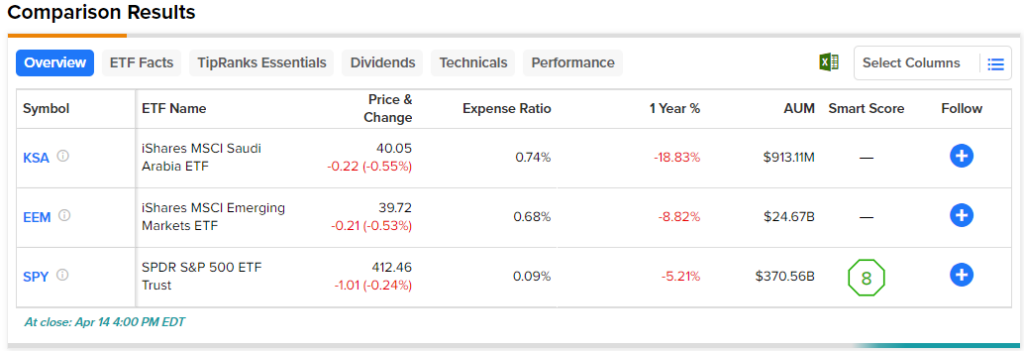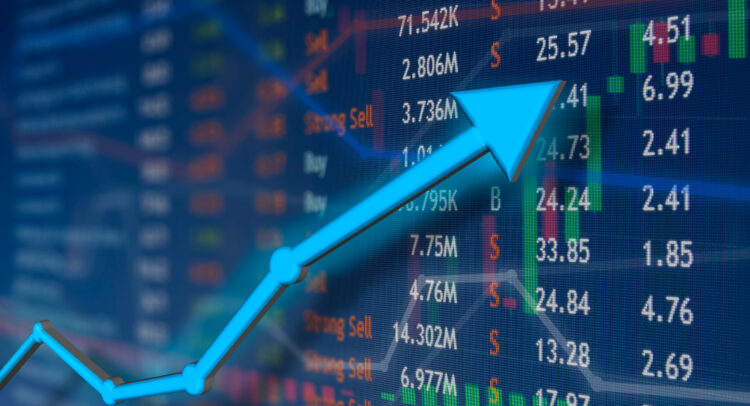It’s well-known that emerging markets have underperformed U.S. markets in recent years. The S&P 500 (SPX) and Nasdaq (NDX) boast annualized returns of roughly 16% and 17%, respectively, over the past three years. Therefore, it’s a tall order for other markets to keep up with these major U.S. indices. However, there are some diamonds in the rough that have bucked the trend. In fact, while it doesn’t receive much attention, the iShares Saudi Arabia ETF (NYSEARCA:KSA) has quietly posted a scintillating annualized return of nearly 20% over the past three years, outpacing both the S&P 500 and Nasdaq.
Claim 50% Off TipRanks Premium and Invest with Confidence
- Unlock hedge-fund level data and powerful investing tools designed to help you make smarter, sharper decisions
- Stay ahead of the market with the latest news and analysis so your portfolio is always positioned for maximum potential
KSA has even vastly outperformed the broader emerging markets-focused iShares MSCI Emerging Markets ETF (NYSEARCA:EEM), which has returned about 7% on an annualized basis over the same time frame. It also still has plenty of long-term potential ahead of it.
What is KSA ETF?
KSA is a $913 million iShares ETF from BlackRock (NYSE:BLK) that seeks to “track the investment results of a broad-based index composed of Saudi Arabian equities,” according to the ETF’s fact sheet. As you may have guessed, the ticker derives from “Kingdom of Saudi Arabia,” the country’s official name.
While ETFs can be used to diversify one’s holdings or to invest in a sector as a whole instead of a single stock, they can also be used to gain exposure to markets that most investors would otherwise have difficulty accessing. This ETF is a good example of that, as it gives U.S. investors (and non-Saudi investors in general) a convenient way to gain access to the Saudi market, which has historically been closed off to foreign investors.
More Than Just Oil
When most people think of the Saudi Arabian economy, they obviously think of oil, which makes sense as Saudi Arabia is the world’s second-largest oil producer. Further, the oil company Saudi Aramco is the third-most valuable company in the world with a market cap of $1.92 trillion, trailing only Apple (NASDAQ:AAPL) and Microsoft (NASDAQ:MSFT).
While oil is clearly still the key cog of the Saudi economy, there is a lot more to this market than just oil. In fact, energy isn’t even the largest sector held by the iShares MSCI Saudi Arabia ETF — financials take the top spot with a weighting of over 40% (as of the end of Q1 2023).
Banks like Al Rajhi Bank and Saudi National Bank are the fund’s top two holdings, with weightings of 13% and 9.6%, respectively. In fact, banks make up six of the ETF’s top 10 holdings. These banks benefit from a zero-interest deposit base as Islamic law dissuades individuals from collecting interest on loans, so they benefit from rising interest rates worldwide as they can allocate assets into interest-bearing assets but do not have to pay higher rates to their depositors.
The materials sector takes up 21% of the KSA ETF, and all other sectors, including energy, have single-digit percentage weightings. Below, you’ll find an overview of KSA’s top holdings using TipRanks’ Holdings tool.

The ETF holds 111 positions, meaning that it covers a wide swath of the Saudi market. The top 10 holdings make up nearly 60% of assets, so it isn’t as diversified as it may look. That said, an ETF like this is more of a concentrated bet on a specific emerging market, so I don’t see that as necessarily being a problem here.
In addition to this prominent banking sector, Saudi Arabia has been working diligently to diversify its economy beyond energy in recent years under its ‘Vision 2030’ plan. Saudi Arabia is also trying to modernize its capital markets and increase access to them, which should further benefit Saudi stocks. IPOs are increasing in frequency — recent examples include Elm, a fintech company, and Americana Restaurants, which owns the franchises of Yum! Brands restaurants like Pizza Hut and KFC in the region.
Under Mohammed bin Salman, Saudi Arabia’s Public Investment Fund is becoming well-known for making large investments outside of the oil industry, such as purchasing Newcastle United in the English Premier League as well as launching the upstart LIV Golf tour, which has pried quite a few high-profile golfers away from the more established PGA Tour.
Other high-profile investments include a $45 billion investment in the Softbank Vision Fund, a major venture capital fund led by famed technology investor Masa Son and a large stake in Uber (NYSE:UBER).
Of course, even with this significant effort to diversify, it should be noted that oil still plays a massive role in the overall Saudi economy. When oil prices are up, this is good for the Saudi economy as a whole and drives growth in these other sectors like banking, construction, and consumer discretionary. Conversely, when oil is down, this is a net negative for the rest of the economy.
A Demographic Boost
Saudi Arabia is also intriguing from a demographic perspective. It has a very young population, with a median age of under 30. It has experienced a population boom in recent decades, and its population continues to grow at 1.6% per year.
Additionally, more women are beginning to enter the workforce as reforms take hold. This means that Saudi Arabia could benefit from a strong workforce and growing demand in the future when many developed nations are going to be dealing with aging populations and shrinking workforces.
A Relatively High Expense Ratio but Reasonable Valuation
One negative about KSA is that with an expense ratio of 0.74%, the fees are relatively high, but this is a more difficult market to access, and there aren’t many alternatives for interested investors. Furthermore, it’s not out-of-line with other country-specific ETFs that focus on markets that are more off the beaten path.
For comparison, the much larger aforementioned EEM ETF has an expense ratio of 0.68%. These types of ETFs generally have higher expense ratios than investing in an S&P 500 ETF. KSA stock also pays a dividend, and it currently yields approximately 1.9%.

One other factor to note is that in terms of valuation, KSA’s holdings are in an interesting place after the fund’s impressive three-year run. With an average P/E ratio of just under 16, they are cheaper than the average multiple for the S&P 500 (currently 23.6), but they are more expensive than emerging markets as a whole — EEM’s holdings have an average price-to-earnings ratio of 11.2.
Investor Takeaway
Based on its strong recent performance and the potential for further growth as the economy diversifies and the population and workforce expand, Saudi Arabia presents an appealing long-term investment opportunity. KSA gives investors a convenient way to unlock access to this market.
















